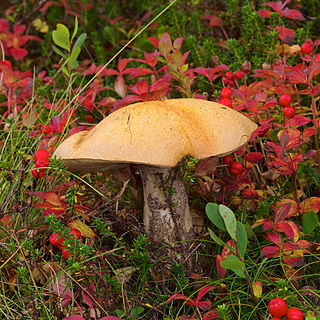Leccinum versipelle
Species of fungus From Wikipedia, the free encyclopedia
Leccinum versipelle, also known as Boletus testaceoscaber, dark-stalked bolete, or orange birch bolete, is a common species of mushroom that may be edible when given the right preparation. It is found below birches from July through to November, and turns black when cooked.
| Leccinum versipelle | |
|---|---|
 | |
| Scientific classification | |
| Domain: | Eukaryota |
| Kingdom: | Fungi |
| Division: | Basidiomycota |
| Class: | Agaricomycetes |
| Order: | Boletales |
| Family: | Boletaceae |
| Genus: | Leccinum |
| Species: | L. versipelle |
| Binomial name | |
| Leccinum versipelle | |
| Synonyms | |
| |
Taxonomy
Leccinum is a genus of fungi in the family Boletaceae. It was the name given first to a series of fungi within the genus Boletus, then erected as a new genus last century. Their main distinguishing feature is the small, rigid projections (scabers) that give a rough texture to their stalks. The genus name was coined from the Italian Leccino, for a type of rough-stemmed bolete.
Description
The cap is broadly convex, and be buff to yellow-orange or ochre, bright red-brown or brick red. It is felty and grows up to 15 centimetres (6 in) in diameter.[1] The flesh is white to pink, turning green-blue or grey, then black when cut, particularly in the stipe. Tubes are grey-brown, staining as flesh. The spores are brown, or smokey to blackish-brown. The stipe is firm, long and slender, white and covered with small black scales. Stalks are up to 15 cm tall[1] by 3.5 cm wide, whitish, and with many raised, black dots. Spore print is yellow-brown to olive.
- Orange birch bolete (Leccinum versipelle), New Jersey, US
- Stem of a Leccinum mushroom, showing the distinctive scabers
Distribution and habitat
Leccinum versipelle fruits on the ground in mixed woods.[2] It can be found across Europe from August to November.[1]
Edibility
Leccinum versipelle is edible cooked.[1] It is mildly toxic (causing nausea and vomiting) unless given proper heat treatment: frying or boiling for 15–20 minutes is necessary. It is commonly harvested for food in Finland,[3] Latvia, Lithuania, Estonia, Belarus, southeast Alaska and Russia.
References
Wikiwand - on
Seamless Wikipedia browsing. On steroids.


